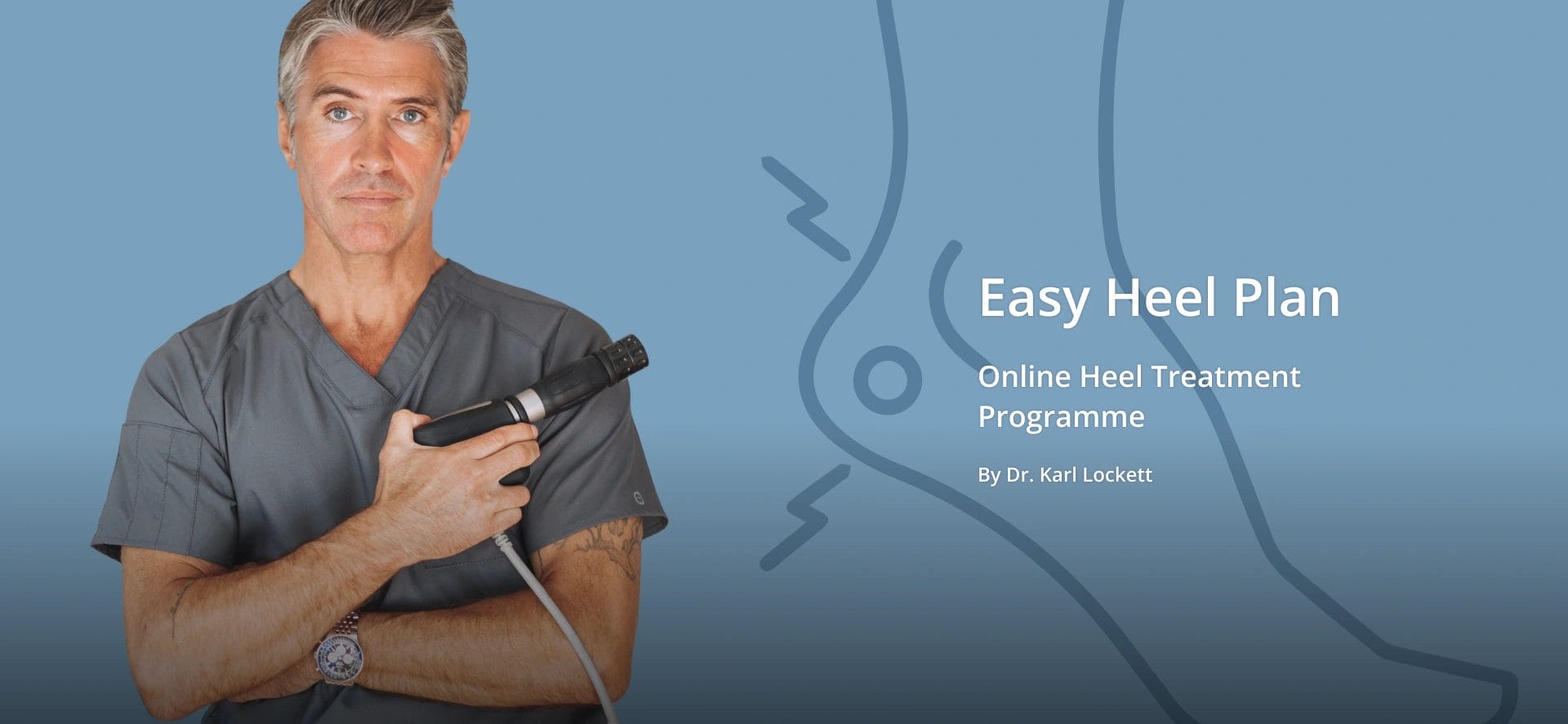HEEL SPUR AT-HOME TREATMENT PLAN
Are you suffering with acute or chronic foot pain? Say goodbye to the frustration of temporary fixes or the need for multiple practitioners. Dr. Karl’s at-home treatment plan is your key to long-lasting relief. His treatment protocol targets the root causes of your heel spur, offering you tried and tested therapies and guidance.
- Footwear instructions – the cushioned shoe myth
- Stretching Vs Strengthening – Dr Karl’s super stretch
- The importance of unloading and how to achieve this
- Convenience and comfort of self treatment at home
- Misinformation and common mistakes with self treatments – many of these may feel good but actually make the condition worse!
Experience the transformation and embrace a life free from constant foot pain. Start Your At-Home Treatment Plan today.
Heel & Foot Pain Treatment Plan Payment Page
$149.00
Offering an alternative to those who seem to have tried everything to heal their heel and foot pain. From Dr Karl, Sydney's leading Plantar Fasciitis and related condition podiatrist, this at-home treatment option takes a different and medically proven approach to heal pain at the source rather than simply masking it.
Our goal is to heal your condition so you can get moving without pain, from waking up in the morning without feeling like you're walking on razors, to simply walking to the shops. Jargon-free and available from any device, treat your heel pain at the source from the comfort of your own home and get back to living the life you want pain-free, quicker.
WHAT ARE HEEL SPURS?
If you have been diagnosed with a heel spur, then you will mostly have an x-ray showing it. Heel spurs rarely cause pain themselves, rather the perceived heel spur pain is the result of inflammation at the site of the heel spur, most commonly caused by the plantar fascia (refer to Plantar Fasciitis Treatments) or the Achilles Tendon (refer to the treatment of Achilles Tendonitis), either underneath or at the back of the heel respectively.
You can have a plantar heel spur (under the heel) or a posterior heel spur (at the back of the heel).
It is thought that the formation of the heel spur is due to the pulling and irritation on the heel bone, whereby that bone responds by growing more bone, in the direction of the pull.
HEEL SPUR TREATMENT
Heel spur treatment, regardless of location, is designed to stop the inflammation and irritation at the site. Once we know why the tendon or fascia is causing irritation to the site, we can stop the pain at our sports podiatry clinic. We will not be looking to remove the spur, surgically or otherwise. Don’t be too concerned about the heel spur itself, it’s not the problem, in most cases.
You may also like to read our section about plantar fasciitis and heel pain treatments.
CASE STUDY: HEEL PAIN JUNE 2012
A 37-year-old lady presents at the clinic complaining of pain in her left heel only of approximately 18 months. She shows x-rays of both feet and there are large heel spurs underneath both heels.
Her heel pain is there every day, particularly in the mornings when she steps down from her bed. She confirms there is no discomfort in her right foot even though a 1cm heel spur is visible. Once again, this supports the theory that the pain comes from something other than the spur.
This patient is slightly overweight and walks daily in ballet flats and on assessment has very tight gastrocnemius muscles, leading to a limited range of motion in her ankle joints.
In addition to feeling foot pain in the base of the heel, she describes cramping in her calf muscles, particularly at the end of the day.
HEEL PAIN ASSESSMENT
With the patient lying face-up on the treatment table, firm pressure is applied to the medial side of the heel and the base of the heel, around the sight of pain, and in the vicinity of the heel spur. There is a positive jump response and the patient reports that the pain produced by the pressure feels the same as the discomfort that she feels daily.
The patient is advised that her symptoms are consistent with plantar fasciitis, and that what she perceived as heel spur pain is actually coming from inflammation within the plantar fascia.
The heel spur is not causing the pain. She has the typical signs and symptoms of plantar fasciitis which is the most common cause of pain beneath the heel.
BIO-MECHANICAL ASSESSMENT FOR HEEL PAIN
Bisection lines are drawn on the patient’s feet and legs and she is observed walking and running on a treadmill. Digital data is stored and her video is replayed in slow motion.
This patient does not overpronate, her feet stand up straight when she walks (and runs) but she appears to have an early heel lift. Her gastrocnemius muscles are tight so that they function short and they pull the heel off the ground too early in the gait cycle.
It is not uncommon to see tight calf muscles and early heel lift in patients with heel conditions such as plantar fasciitis.
In a static, weight-bearing position and with the patient in a relaxed stance position, measurements are taken of the arch height of both feet. Her readings are remarkable: 29mm on the right foot and 32mm on the left. The patient is advised that her arches are very high and that she needs supports in order to remove the strain from the plantar fascia and take pressure off the heel and ball of the foot.
HEEL PAIN TREATMENT
DRY NEEDLING FOR HEEL PAIN
Acupuncture needles are inserted using trigger point therapy along with the soleus and gastrocnemius muscles. This assists in “softening” and “loosening” the muscles which in turn helps to lengthen them, and increase the range at the ankle joint.
The reduction in the pull of these muscles on the heel will assist recovery of the plantar fascia and will reduce the heel pain.
ORTHOTICS FOR HEEL PAIN
Using a 3D scanner, digital images are captured of the patient’s feet as she lies face down and her foot held in an optimal position. These images will be used to make prescription orthotics that will support the arch of the foot and reduce strain on the plantar fascia.
This will allow the plantar fasciitis to settle and the heel pain will stop. The orthotics will have some padding under the heel to accommodate the heel spur, but the patient understands that the heel spurs are not the problem and therefore is not the focus of treatment, but the plantar fascia is.
ICE PACKS FOR HEEL PAIN
The patient is advised to apply ice packs to the base of the heel every day for approximately 20 to 30 minutes. This is to reduce inflammation in the plantar fascia which will accelerate healing and also reduce heel pain.
FIRM SHOES FOR HEEL PAIN
The patient is advised that her current footwear is insufficient and that she must use shoes that are more robust, even if just for a short while until her condition has settled. She is given a list of appropriate shoes that she can shop for.
CALF STRETCHING FOR HEEL PAIN
This lady is shown how to stretch her calf muscles in a very specific manner, to ensure she does not irritate the heel as she stretches her calves. The dry needling that was done will facilitate this stretching process and over time her calf range will improve.
This will reduce the pull on the heel and allow the plantar fascia to recover, reducing heel pain. Once again, this lady understands that the heel spur is not the problem here and her treatment program is designed around reducing strain and inflammation on the plantar fascia, and encouraging healing of the plantar fasciitis.
Written by Karl Lockett
COMMON QUESTIONS ABOUT HEEL SPURS
It is not possible to dissolve heel spurs once they have formed. Rather, treatment is focused around treating the root cause (plantar fasciitis or Achilles tendonitis) which has put pressure at the tendon / fascia attachment site, leading to bone being deposited there. As we mentioned earlier, heel spurs are not the cause of the pain, but rather the inflammation of the soft tissue structures in the area is. Only severe heel spurs warrant the careful consideration of a foot surgeon, for debridement / removal.
If the underlying cause of the heel spurs is left untreated, it is possible that they may continue to grow as the body continues to deposit calcium at the site of the tension.
We will not be looking to remove heel spurs surgically or otherwise. In the vast majority of patients, plantar fascia release or other surgical treatments are simply unnecessary. Treatment is aimed at the root cause of the tension that has lead to the spur formation in the first instance. Once the inflammatory condition is treated, patients find that what they thought was heel spur pain disappears. We will recommend for surgery as a last resort once all conservative measures have been exhausted.
Once heel spurs are present, they do not go away. By now you will know that since spurs do not always cause pain, if we treat the root cause of the spur formation, then the spur will not be problematic or detrimental to foot health in the long term. The spur can stay, the plantar fasciitis or Achilles tendonitis must go!






